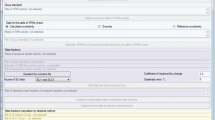Abstract
Researcher’s interest is increasing worldwide to study the role of trace elements in brain tissues. This paper discusses the application of k 0-instrumental neutron activation analysis to study the distribution of trace elements in seven different anatomical regions of goat brain. These regions include cerebellum, cerebrum, medulla oblongata, meninges, midbrain, pons and thalamus. The analysis protocol followed 1 h irradiation at 10 MW material testing type nuclear research reactor with nominal thermal neutron flux of 2 × 1013 cm−2 s−1. A total of 14 elements, namely Br, Co, Cr, Eu, Fe, Hg, K, Na, Rb, Sb, Sc, Se, Tb and Zn were determined in all parts. Reliability of the method was assessed by analyzing biological reference material IAEA-336 (lichen). On comparing the analytical results with the healthy human brain data, it showed that eight elements (Eu, K, Na, Rb, Sb, Sc, Se, Tb) were found with relatively higher elemental concentrations in human brain. Principal component analysis revealed distribution of seven parts in different three groups having similar elemental concentrations of elements.



Similar content being viewed by others
References
Que EL, Domaille DW, Chang CJ (2008) Metals in neurobiology: probing their chemistry and biology with molecular imaging. Chem Rev 108:1517–1549
Yabushita Y, Kanayama Y, Tarohda T, Tuji T, Washiyama K, Amano R (2003) Brain regional distribution of the minor and trace elements, Na, K, Sc, Cr, Mn Co, Zn and Se, in mice bred under Zn-deficient, -adequate and -excessive diets. J Radioanal Nucl Chem 257:399–403
Panayi AE, Spyrou NM, Ubertalli LC, Akanle OA, Part P (2000) Difference in trace element concentrations between the right and left hemispheres of human brain using INAA. J Radioanal Nucl Chem 244:205–207
Zecca L, Tampellini D, Rizzio E, Giaveri G, Gallorini M (2001) The determination of iron and other metals by INAA in cortex, cerebellum and putamen of human brain and in their neuromelanins. J Radioanal Nucl Chem 248:129–131
Liu H-M, Tsai S-JJ, Cheng F-C, Chung S-Y (2000) Determination of trace manganese in the brain of mice subjected to manganese deposition by graphite furnace atomic absorption spectrometry. Anal Chim Acta 405:197–203
Amano R, Oishi S, Ishie M, Kimura M (2001) Brain regional distributions of the minor and trace elements, Na, Mg, Cl, K, Mn, Zn, Rb and Br, in young and aged mice. J Radioanal Nucl Chem 247:361–384
Stedman JD, Spyrou NM (1998) Hierarchical clustering into groups of human brain regions according to elemental composition. J Radioanal Nucl Chem 236:11–14
Andrasi E, Varga I, Dozsa A, Reffy A, Nagy GJ (1994) Classification of human brain parts using pattern recognition based on inductively coupled plasma atomic emission spectroscopy and instrumental neutron activation analysis. Chemom Intell Lab Syst 22:107–114
Duflou H, Maenhaut W (1990) Application of principal component and cluster analysis to the study of the distribution of minor and trace elements in normal human brain. Chemom Intell Lab Syst 9:273–286
Michalke B, Nischwitz V (2010) Review on metal speciation analysis in cerebrospinal fluid—current methods and results: a review. Anal Chim Acta 682:23–36
Faa G, Lisci M, Caria MP, Ambu R, Sciot R, Nurchi VM, Silvagni R, Diaz A, Crisponi G (2001) Brain copper, iron, magnesium, zinc, calcium, sulfur and phosphorus storage in Wilson’s disease. J Trace Elem Med Biol 15:155–160
Preedy VR, Watson RR, Martin CR (2011) Handbook of behavior, food and nutrition. Springer, New York
Ördögh M, Fazekas S, Horváth E, Óváry I, Pogány L, Sziklai IL, Szabó E (1983) The regional distribution of copper and other trace elements in the human brain with special reference to Wilson’s disease. J Radioanal Nucl Chem 79:15–21
Stedman JD, Spyrou NM (1997) Elemental analysis of the frontal lobe of “normal” brain tissue and that affected by Alzheimer’s disease. J Radioanal Nucl Chem 217:163–166
De Corte F (2001) The standardization of standardless NAA. J Radioanal Nucl Chem 248:13–20
Simonits A, De Corte F, Hoste J (1975) Single comparator methods in reactor neutron activation analysis. J Radioanal Chem 24:31–46
Wasim M, Arif M, Zaidi JH, Anwar Y (2009) Development and implementation of k 0-INAA standardization at 10 MW Pakistan research reactor-1. Radiochim Acta 97:651–655
Wasim M, Zaidi JH, Arif M, Fatima I (2008) Development and implementation of k 0-INAA standardization at PINSTECH. J Radioanal Nucl Chem 277:525–529
Dodoo-Amoo D, Landsberger S (2001) Gamma-ray self attenuation calculations in neutron activation analysis: a problem overlooked. J Radioanal Nucl Chem 248:327–332
Wasim M (2010) GammaLab: a suite of programs for k 0-NAA and gamma-ray spectrum analysis. J Radioanal Nucl Chem 285:337–342
Wold S, Esbensen K, Geladi P (1987) Principal component analysis. Chemom Intell Lab Syst 2:37–52
Vandeginste BGM, Massart DL, Buydens LMC, Jong SD, Lewi PJ, Smeyers-Verbeke J (1998) Handbook of chemometrics and qualimetrics, part B. Elsevier, Amsterdam
Daud M, Wasim M, Khalid N, Zaidi JH, Iqbal J (2009) Assessment of elemental pollution in soil of Islamabad city using instrumental neutron activation analysis and atomic absorption spectrometry techniques. Radiochim Acta 97:117–122
Wasim M, Hassan MS, Brereton RG (2003) Evaluation of chemometric methods for determining the number and position of components in high-performance liquid chromatography detected by diode array detector and on-flow 1H nuclear magnetic resonance spectroscopy. Analyst 128:1082–1090
De Corte F, Simonits A (2003) Recommended nuclear data for use in the k 0 standardization of neutron activation analysis. At Data Nucl Data Tables 85:47–67
Guisun Z, Yinson W, Mingguang T, Min Z, Yongjie W, Fulin Z (1991) Preliminary study of trace elements in human brain tumor tissues by instrumental neutron activation analysis. J Radioanal Nucl Chem Art 151:327–335
Author information
Authors and Affiliations
Corresponding author
Rights and permissions
About this article
Cite this article
Wasim, M., Arif, M. & Iqbal, M.S. Determination of elements in different parts of goat brain using k 0 instrumental neutron activation analysis. J Radioanal Nucl Chem 300, 249–254 (2014). https://doi.org/10.1007/s10967-014-2978-4
Received:
Published:
Issue Date:
DOI: https://doi.org/10.1007/s10967-014-2978-4




